Update #3: Mystery Foto #28 Reveals Another Piece of Long Island History in Garden City
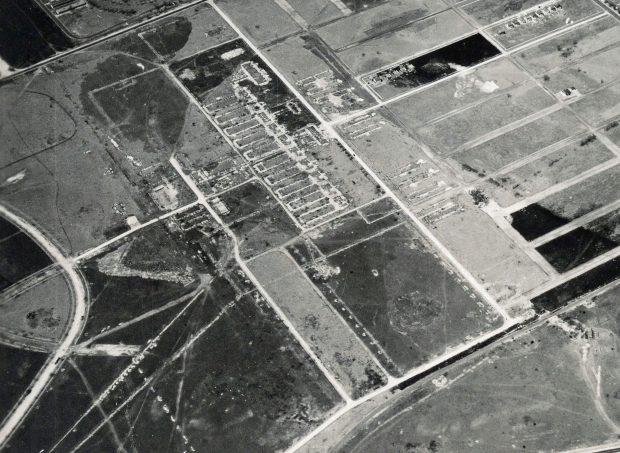
Mystery Foto #28 has uncovered a piece of Long Island history. Garden City Village Historian Bill Bellmer notes "the aerial shows the Camp Mills Base Hospital remains, one of my local specialties. The image you posted is better than any other that I have."
Bill has provided the following description and images of the Camp Mills Base Hospital Complex then considered Mineola, now in the Village of Garden City.
Update #1: Bill Bellmer: "The area (and all the land south of the Town line on Old Country Road was always in Garden City as defined by A. T. Stewart (although not in the Village itself until it was incorporated in 1919). The area was referred to as Mineola because it was close to the Mineola station just as the present county buildings are (ZIP code-wise)."
Enjoy,
Howard Kroplick
Base Hospital, Camp Mills, Long Island, NY (Circa 1920)
The base hospital at Camp Mills was situated in Nassau County, Long Island, N. Y., about 10 miles from the eastern boundary of Greater New York, and 1 mile, to the east, from Mineola.
The terrain is practically flat. The soil is a sandy loam in which there is a small amount of gravel. It readily pulverizes in dry weather, forming easily carried dust, and becomes a tenacious mud after rains.
The climate is moderate during the greater portion of the year. In the winter there is an occasional severely cold spell; the spring and fall are delightful; and during the summer about two or three weeks only might be considered uncomfortably warm.
Camp Mills was selected as a mobilization camp for the Rainbow Division (42nd), so called, because the sources of its component elements were geographically diversified. The division assembled in the early part of September, 1917; and, after a training period of one and one-half months, embarked for France. Because it was known that this division would remain but a short time in the United States, and that the subsequent mobilization of divisions was an uncertainty, no cantonment type of base hospital was constructed at Camp Mills at this time. A camp hospital, composed of a few existing buildings and of tentage mostly, was organized for the care of the sick of the 42nd Division.
The organized camp hospital remained at Camp Mills, upon the departure of the 42nd Division, to care for the sick of that command whom it was necessary to leave in the United States. It was fortunate that the hospital was in existence, for on October 26, 1917, the 41st Division was ordered from Camp Greene, N. C., to Camp Mills, with the view to its embarkation for France within a short period.
In the general description of the conditions of the various embarkation and debarkation hospitals at the port of Hoboken, it was related how, because of the total inadequacy of the cluster of hospital tents for the care of the sick of the 41st Division at Camp Mills, supervisory control of the hospital at that camp was given to the port surgeon, Hoboken, and how relief from the situation was had by transferring selected patients to civil hospitals in New York City and on Long Island.
It was not until April 6, 1918, that a base hospital was organized. At this time Evacuation Hospital No. 4 was sent to Camp Mills from Camp Crane, Allentown, Pa., and it was utilized in the establishment of a base hospital.
The fair grounds at Mineola contained 6 cattle sheds, 1 poultry house, 1 grand stand, 5 exhibition buildings, 2 small houses for the storage of paint, and the stables. These buildings were occupied by Evacuation Hospital No. 4 on April 9, 1918.
The stables were utilized for quarters for officers. The nurses were domiciled in houses in Mineola, rented by the Quartermaster Corps. The enlisted men were quartered partly in the stables and partly in tents.
aThe statements of fact appearing herein are based on the "History, Base Hospital, Camp Mills, Long Island," by Lieut. Col. A. W. Cutler, M. C., U.S.A., while on duty as a member of the staff of that hospital. The material used by him in the compilation of the history comprised official reports from the various divisions of the hospital. The history is on file in the Historical Division, Surgeon General's Office, Washington, D. C.-Ed.
The hospital mess was at first located in the poultry house. This arrangement was found to be very unsatisfactory, and the lower portion of the grand stand was converted into a kitchen and mess hall, where the enlisted men and ambulatory patients ate. The officers of the organization maintained their own mess in the stables, using the broad isle between the stalls-the sleeping compartments-for a dining hall.
There were no storehouses, so tents and sheds were used in which to store the supplies.
The water supply was derived from Mineola. Its source was artesian wells, and the quality of the water was so excellent as to require no purification treatment.
A sewerage system was constructed so as to connect the various buildings of the fairgrounds with a main sewer, the outlet of which was a small sewage-disposal plant on the grounds. Each cow shed contained two toilet bowls, and each exhibition building had five.
The garbage from the hospital was disposed of to local farmers, who made collections twice daily.
On May 6, 1918, the construction of a surgical pavilion was begun. This building comprised seven rooms and some linen closets, and was planned to house not only the surgical activities, but the eye, ear, nose and throat, X-ray, dental, and genitourinary departments. It was ready for occupancy June 15, 1918, but could not be utilized for surgical operations until later, because of the lack of equipment.
On September 16, 1918, the constructing quartermaster received authority to construct a semipermanent 2,000-bed base hospital. A site was selected northwest of Camp Mills and just to the east of the fairgrounds. Work on the construction of the hospital was rapidly pushed, and the first 600 beds were ready for occupancy on October 26, 1918. The entire group of buildings was completed by February 1, 1919.
The arrangement of the buildings conformed to the ultimate block plan designed in the office of the Surgeon General-block plan E, Figure 13. Each building was two-storied, and, because of the close proximity to one another, were made of fire-resisting material-metal lath with stucco covering.
On September 18, 1919, there being no further use for it, the base hospital was abandoned.
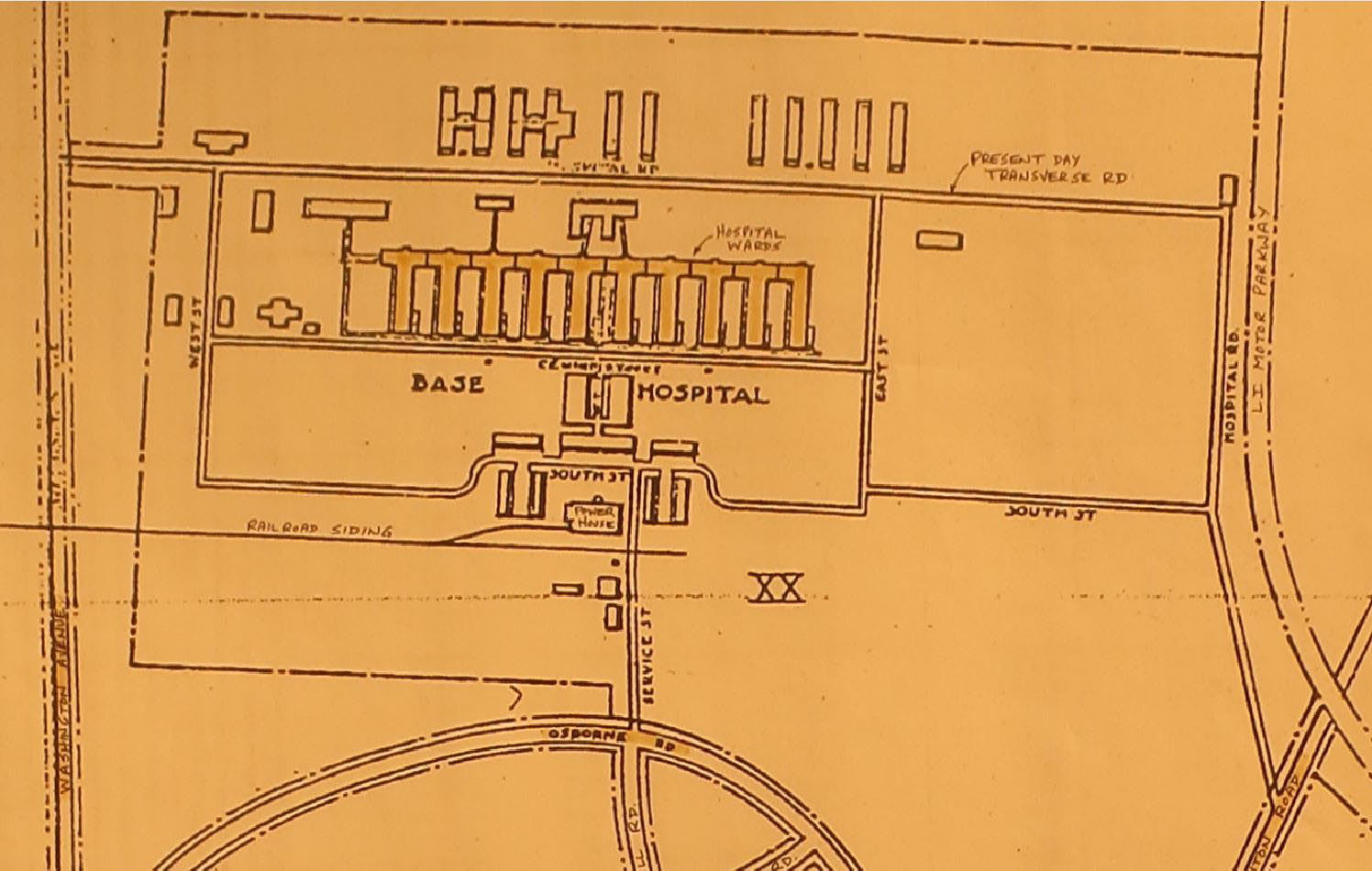
A map of the complex (Courtesy of Bill Bellmer)
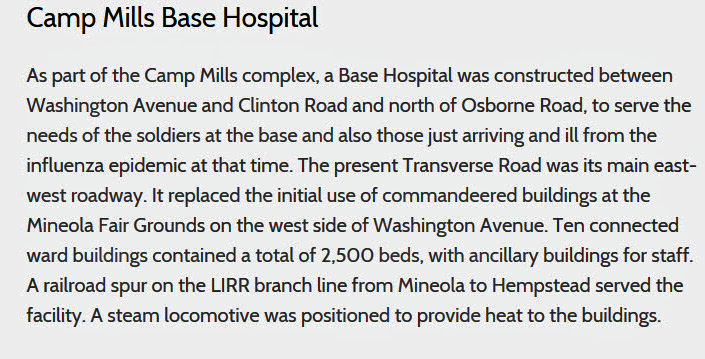
Update #2: Submitted by Frank Mendyk
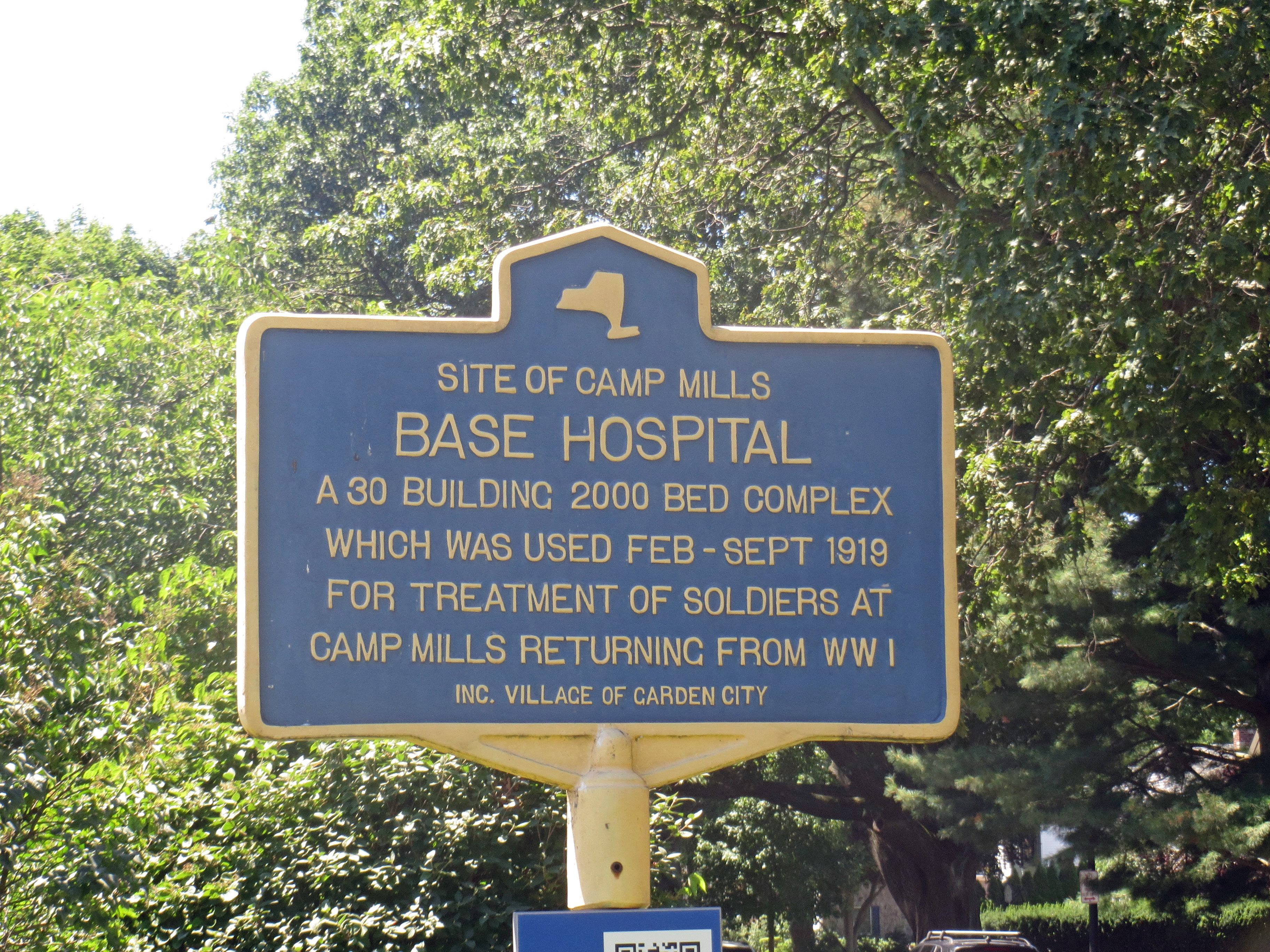
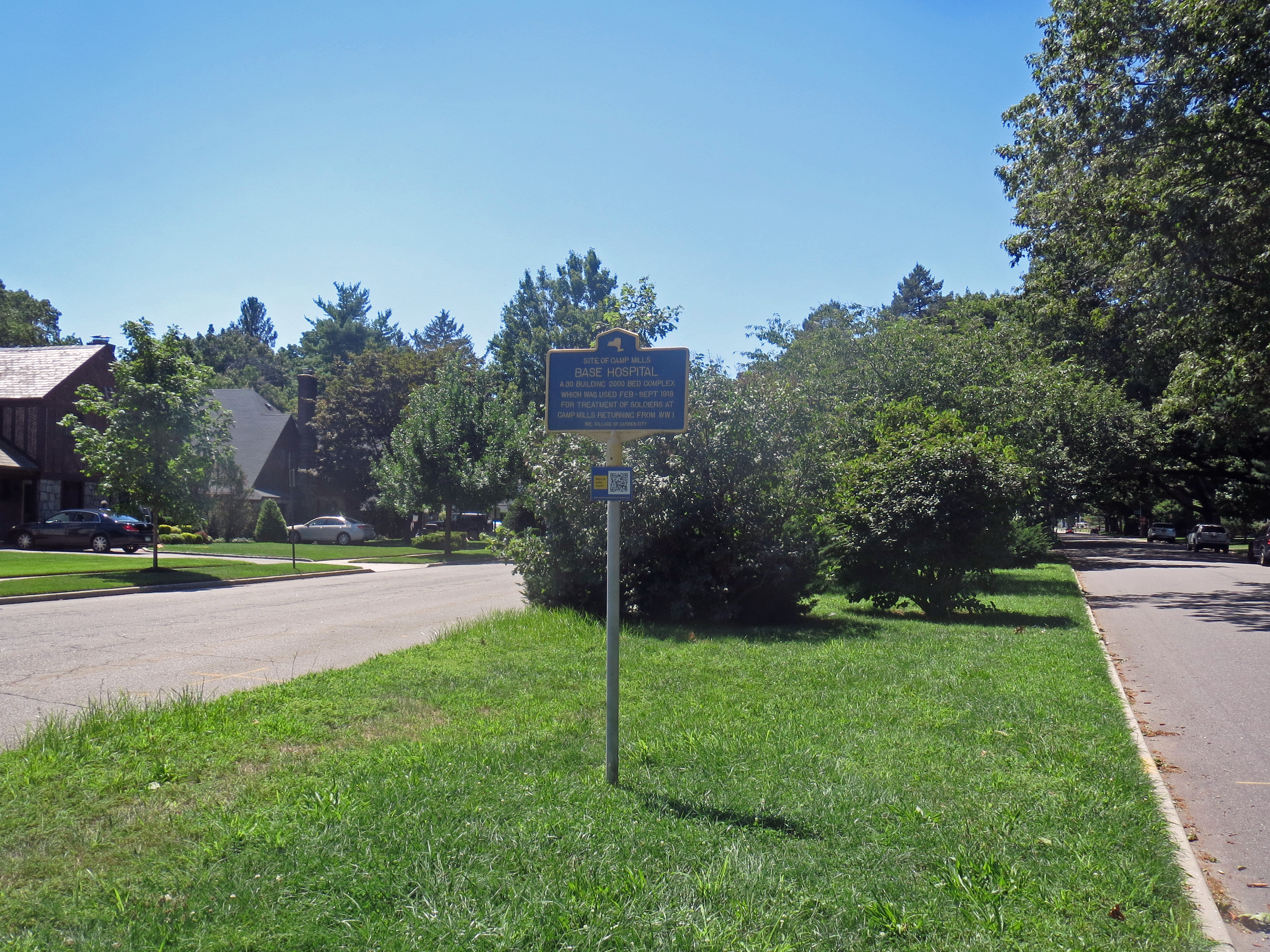
1931 Aerial (Submitted by Richard Panchyk)
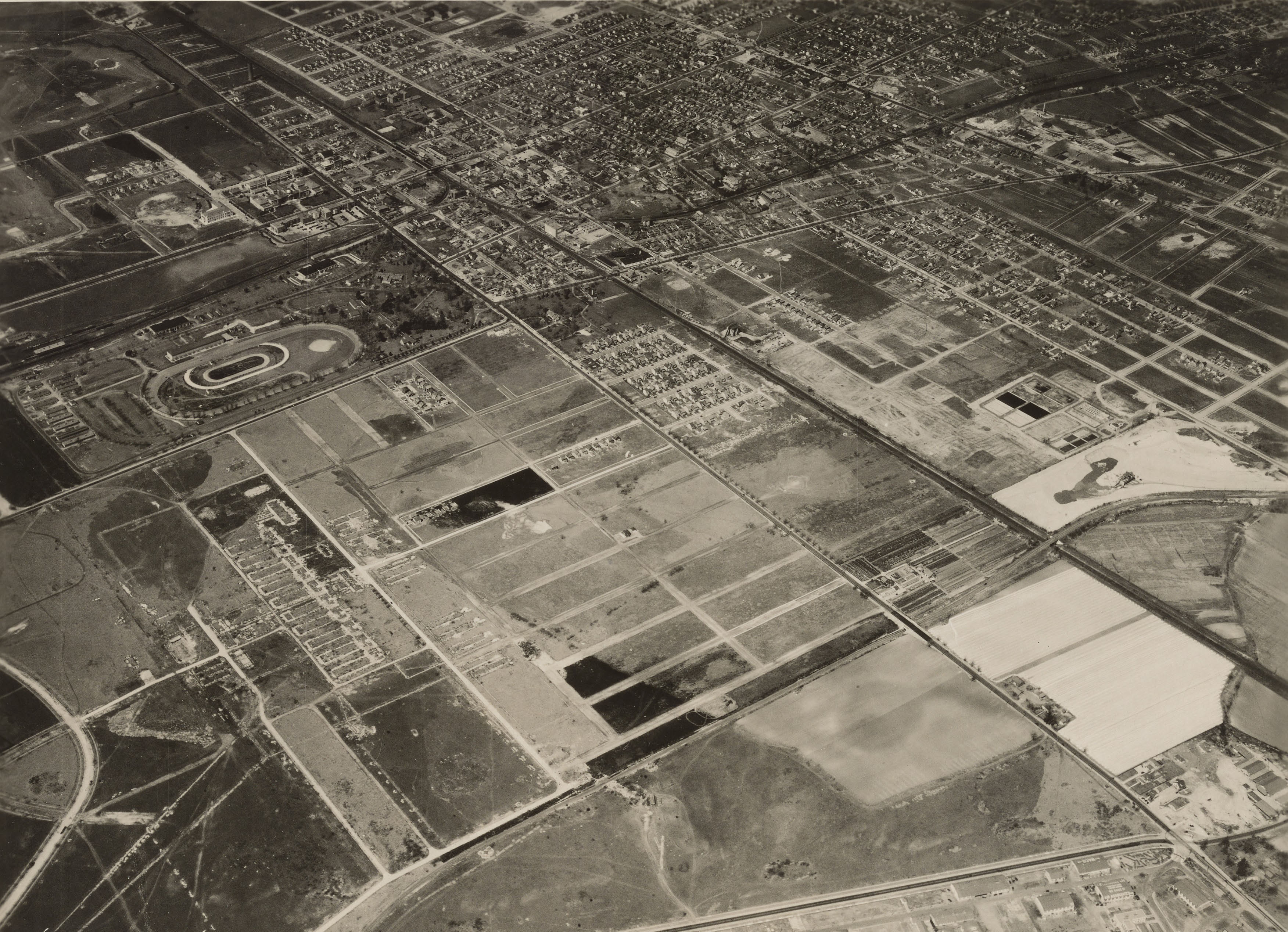
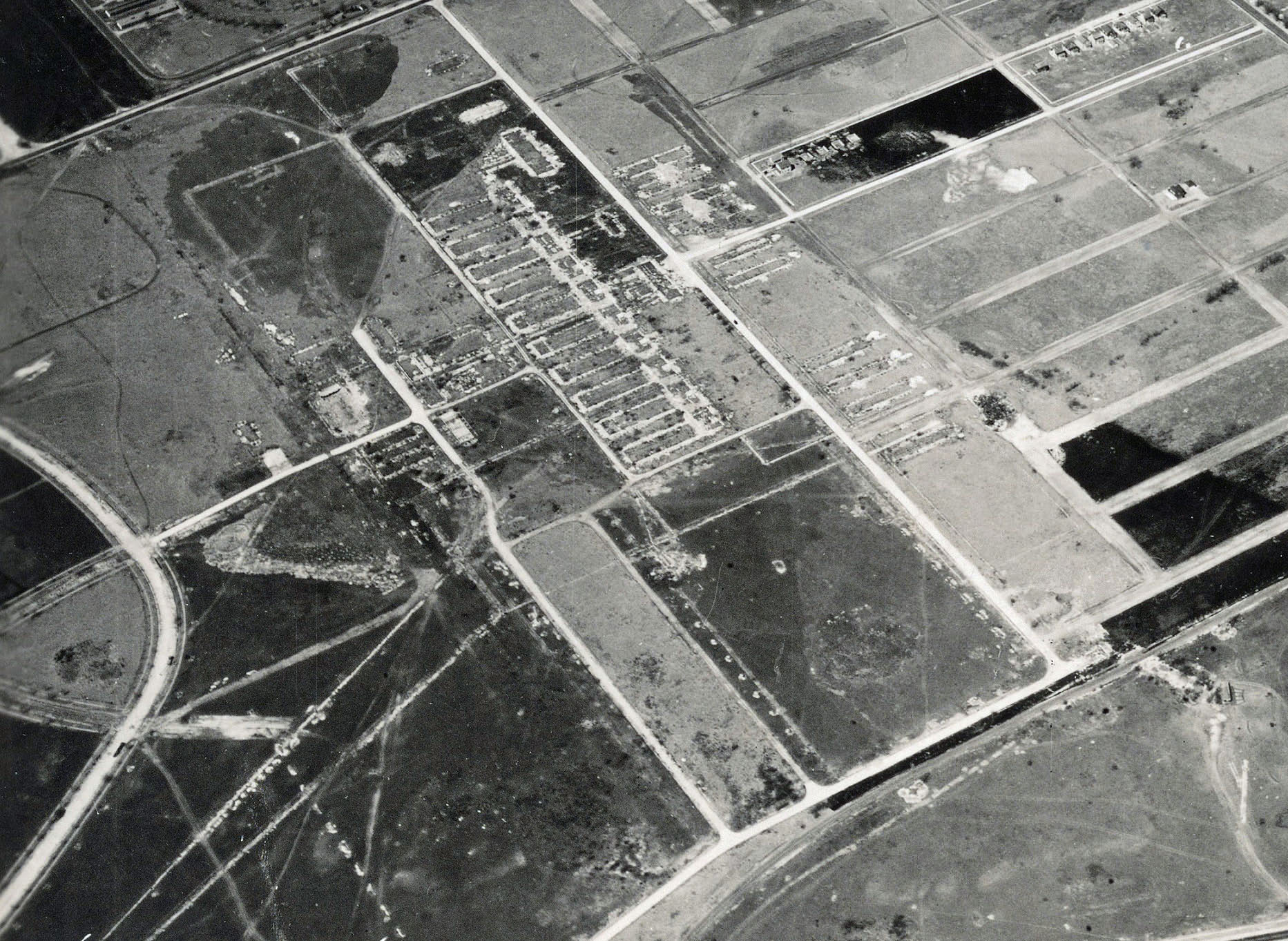
Bill Bellmer: You've identified Transverse Road on the photo. That was built for the hospital complex in 1918. Note the ten rectangles to the left of that road; they were foundations for the ward buildings for 2,500 beds. To the right of the road are foundations for ancillary buildings.
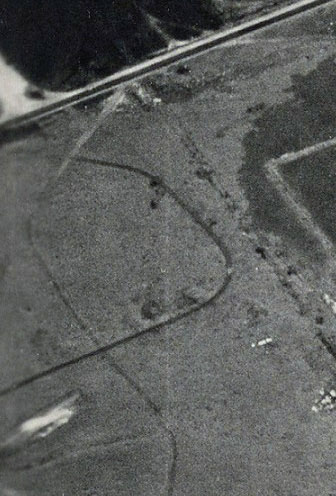
Bill Bellmer: Of particular interest to me is the route of the rail spur from the Mineola-Hempstead branch, which can be seen as a dark line crossing the road from Osborne Rd. to the complex. All this was built in 1918 and was gone by probably 1921.
1926 Aerial (Submitted by Cheryl Lynn Blum)
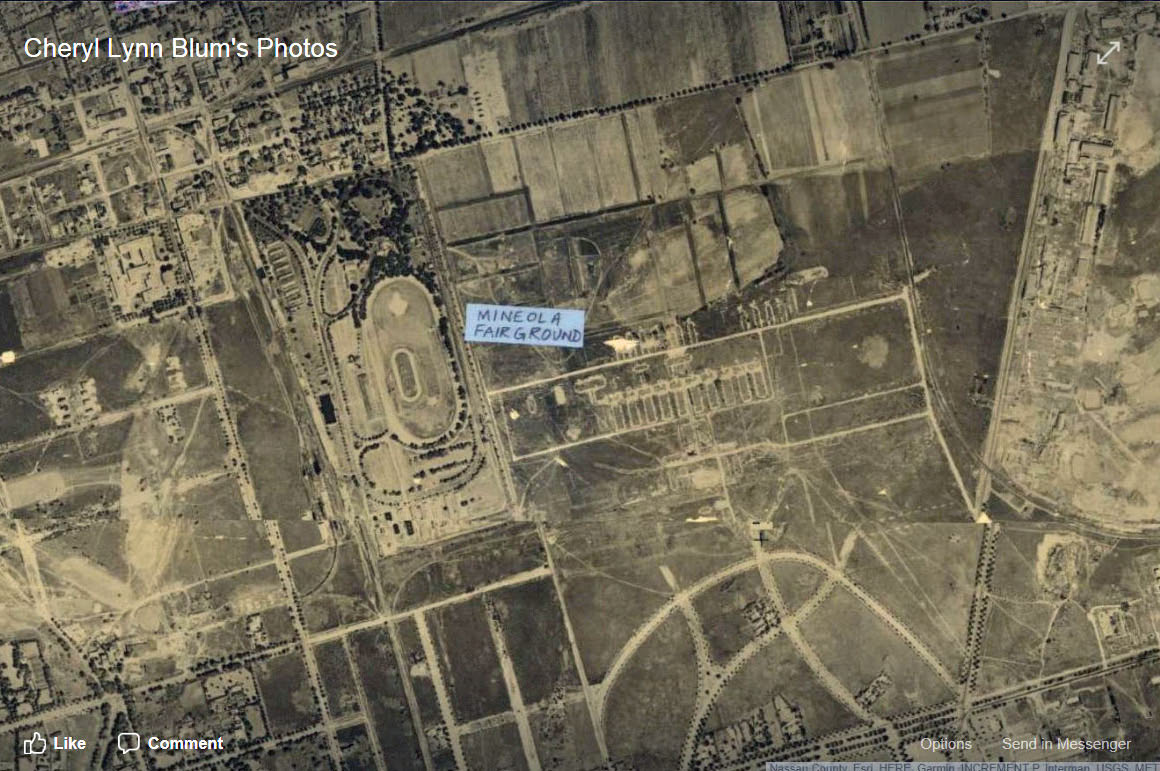
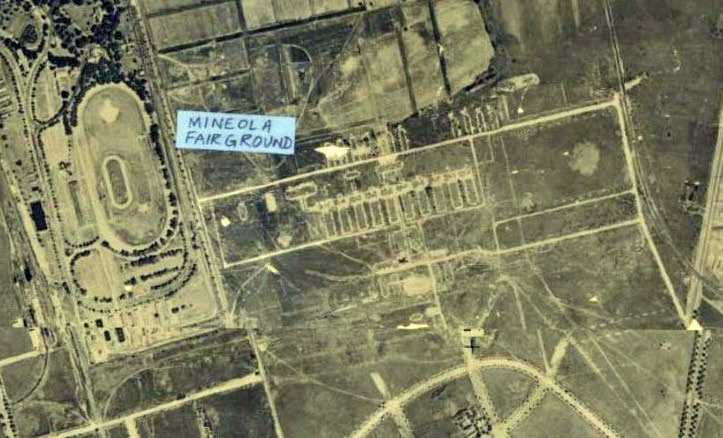
Images courtesy of Bill Bellmer
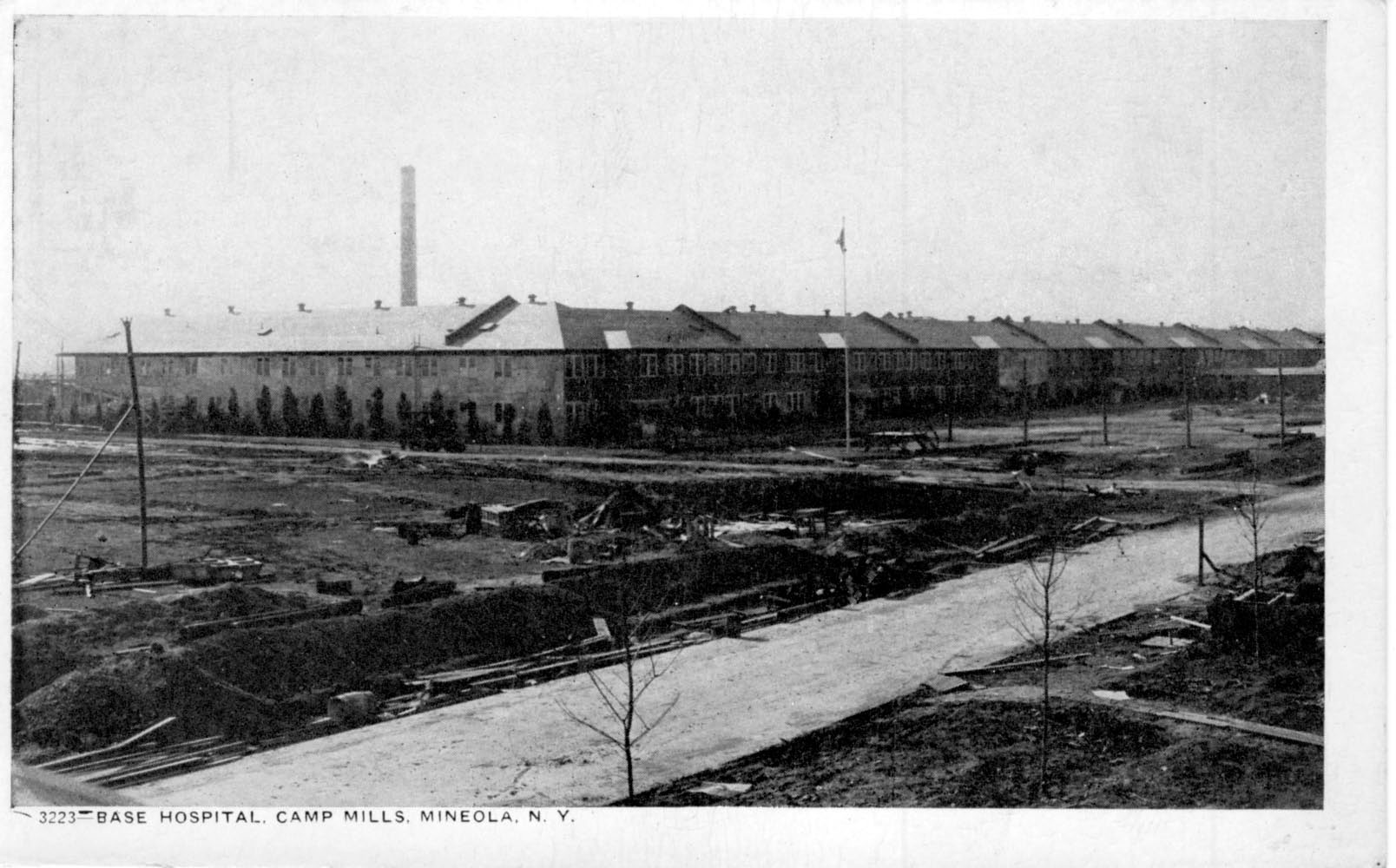
A view of the ward buildings facing SW with Transverse Rd. in the foreground. The rail spur led to a powerhouse with a chimney that can be seen in the background.
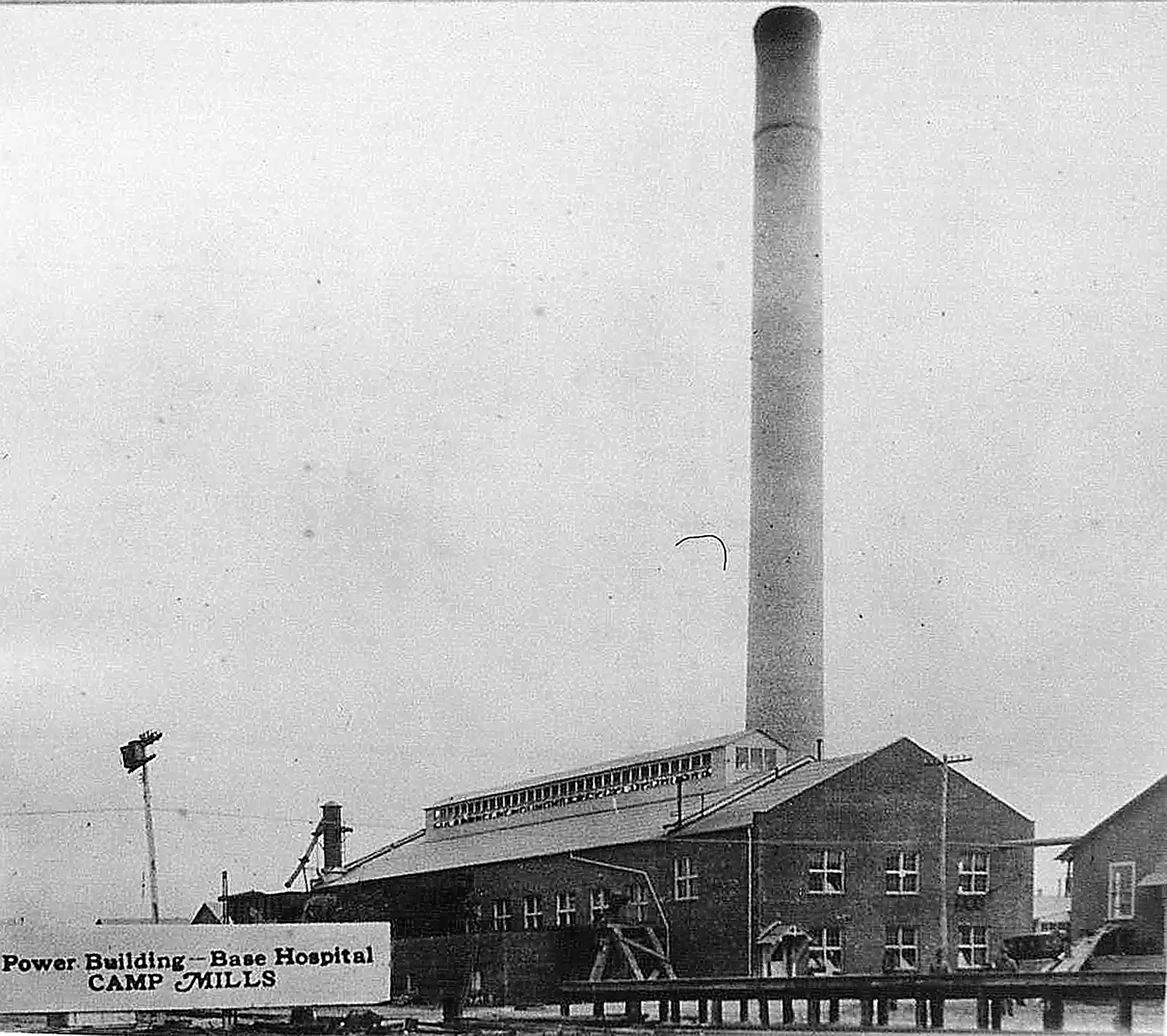
A view of the powerhouse in 1919.
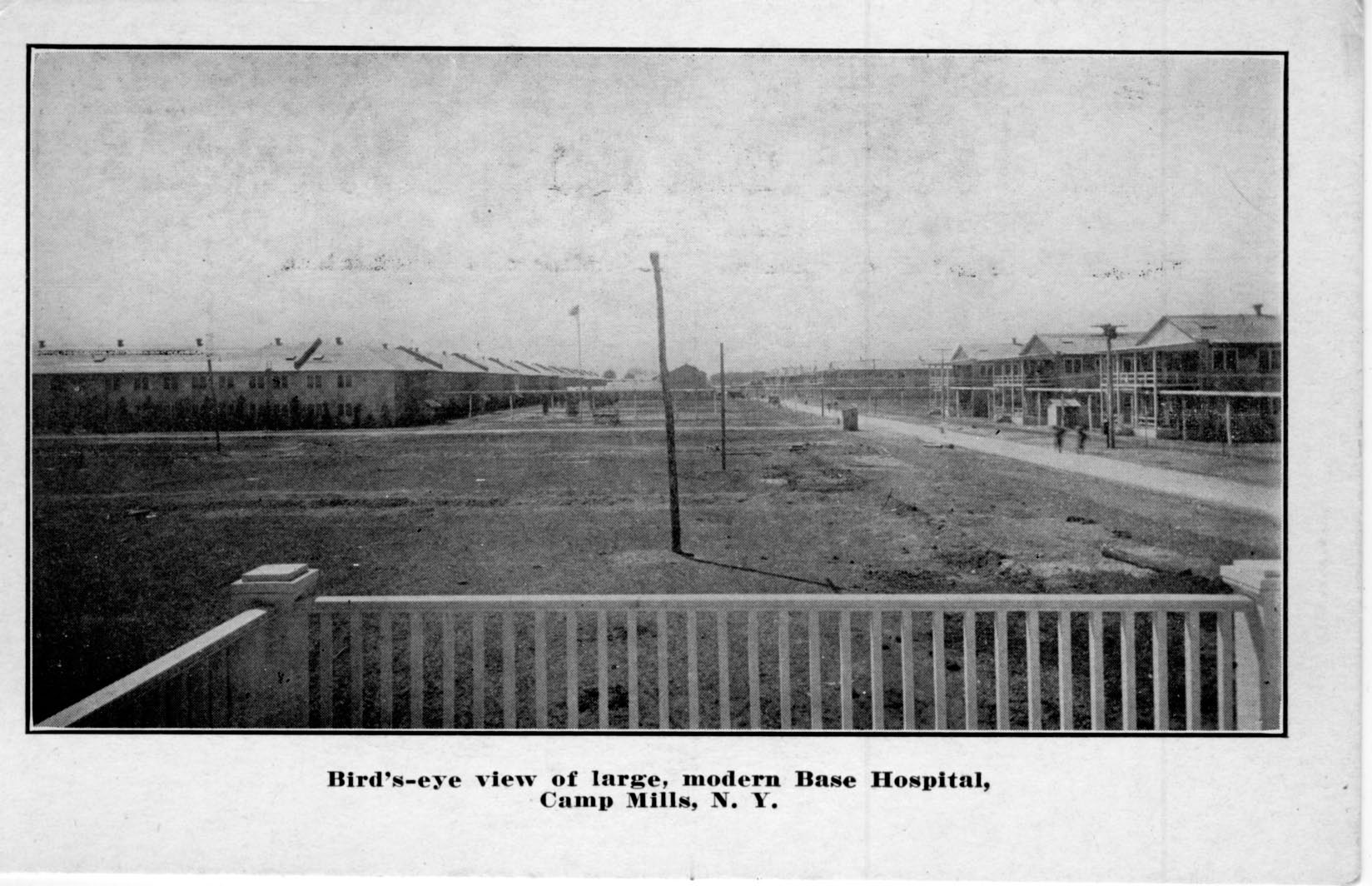
A view showing the buildings north of Transverse Road.
Update #3: Submitted by Lee Chambers
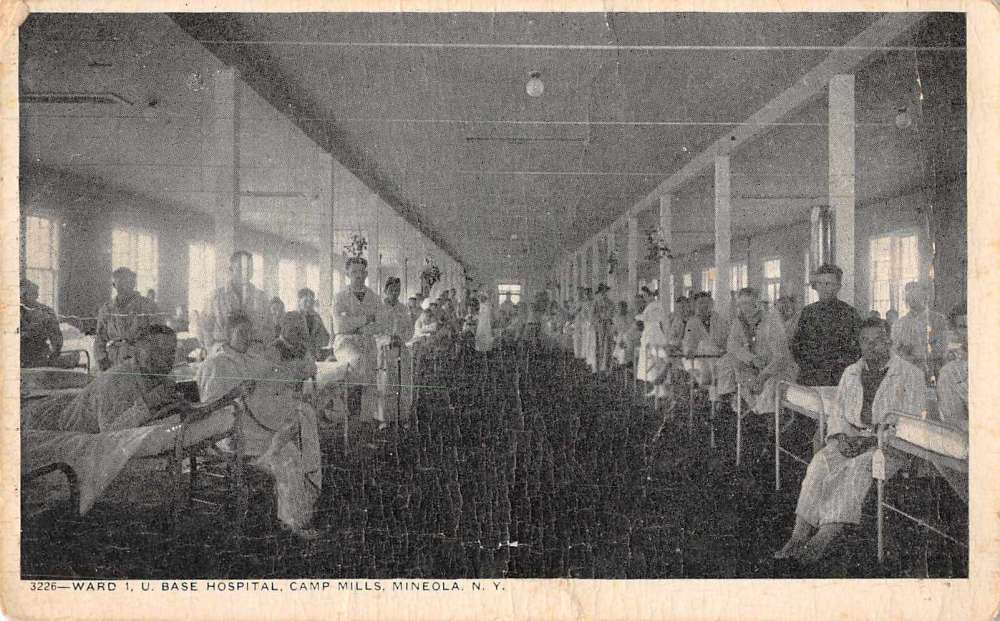

Comments
Interesting info. Never knew there was a spur that extended east from the past Mineola-Hempstead branch. Obviously for coal delivery to the power house. Guess the local farmers made no waste utilizing the refuse for composting and possibly feed for the livestock.
Great Job, Bill Bellmer
Update #1: Bill Bellmer explains why this area was, and still is, referred to as Mineola when it is in Garden City.
Update #2: Frank Mendyk added the above images of the historical marker.
Update #3: Lee Chambers provided a Camp Mills postcard.
AHA! Actually, “OH, WOW!” might better serve. Thanks, one and all. Sam, III
Knowing then the history of Camp Mills when I was in high school in the 1970s I took my metal detector to the narrow strip of land that ran parallel to the south side of Transverse Road and east of Old Country Road. This area was between Transverse and a housing development to the south. At that time it was park-like land used mainly by people walking their dogs. I uncovered a wealth of military artifacts along this strip, including US. Army insignia of specific units, buttons and metal tent stakes galore. Not long ago I was back in Garden City and noted that this strip of land is still undeveloped. My hunch is that it remains ripe for searching.
_______________________________
Howard Kroplick
William, wonderful story.
FYI, I always had great respect for your father as President Johnson’s press secretary and as one of the great political commentators of this era.
Thanks Howard. I will convey to him that he still has a fan on Long Island. At age 84, his public presence remains pretty impressive. Though it is slowly fading, as is inevitable with the march of time.
Liking your metal detecting adventure, Mr. Moyers! You must be referring to the area tucked between Avalon Rd., East Dr., and Clinton Rd. Perhaps a treasure hunt can be arranged via Mr. Bellmer.
Brian:
Thanks for the comment. Actually, it is not the area you refer to, though I do know that area too. I believe you are referring to the strip of land on the west side of Clinton Avenue, just across from where Lindbergh hangered his plane in the days before his famous flight. The area I searched with my detector is a mile or so south of there, not far from the fire station and across the railroad tracks. And now I realize that I erroneously referred to Old Country Road when I meant Clinton Avenue.
My Great Uncle received a hernia operation there in August, 1918 and stayed on as a nurse helping GI.s , dealing with the Flu Epidemic of 1918. In his letter, he gave the address as, “Base Hospital; No. 5, Ward 3, Mineola Long Is. New York. Do I have this right? Thank you.